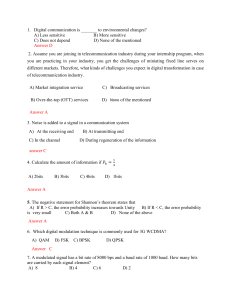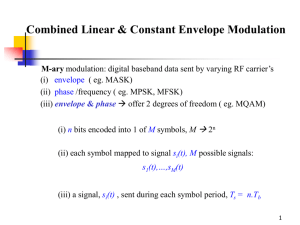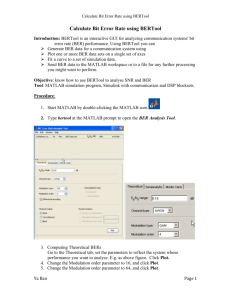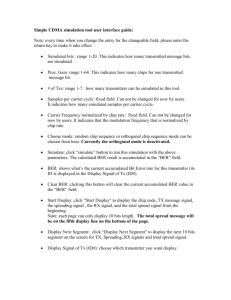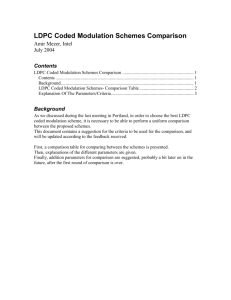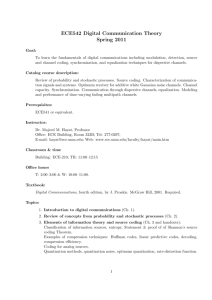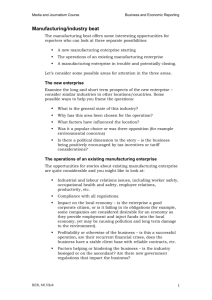April 26 - James K Beard's EE521 and EE551 Pages
advertisement
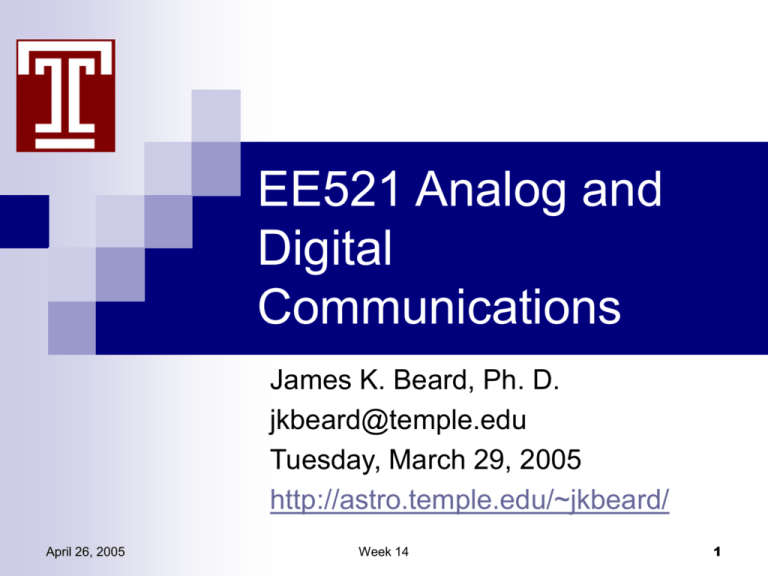
EE521 Analog and Digital Communications James K. Beard, Ph. D. jkbeard@temple.edu Tuesday, March 29, 2005 http://astro.temple.edu/~jkbeard/ April 26, 2005 Week 14 1 April 26, 2005 Week 14 4/19/2005 4/12/2005 4/5/2005 3/29/2005 3/22/2005 3/15/2005 3/8/2005 3/1/2005 2/22/2005 2/15/2005 2/8/2005 2/1/2005 1/25/2005 1/18/2005 Attendance 7 6 5 4 3 2 1 0 2 Essentials Text: Bernard Sklar, Digital Communications, Second Edition SystemView Office E&A 349 MWF 10:30 AM to 11:30 AM Hours during Finals Week TBA Term Projects Due TODAY, April 26 Final Exam Tuesday, May 10, 6:00 PM to 8:00 PM Here in this classroom Posted within 3 days; you get your grade from Blackboard April 26, 2005 Week 14 3 Today’s Topics Term Project Review EE551 in the Fall Evaluation Starts promptly at 9:00 PM Takes 15-20 minutes I will leave the room Need a student volunteer April 26, 2005 Hand out and collect forms Deliver to office here at Ft. Washington Main Office Week 14 4 Term Project Generate a frequency sweep Start frequency: End frequency: Add noise to obtain a noise floor Digitize to 16 bits (later relaxed to 8 bits) Modulate using FSK, BPSK or QPSK Convert from baseband to a carrier frequency Model a fading channel with up to 12 paths. Demodulate and detect Analyze BER April 26, 2005 Week 14 5 Modulation Problems with FSK 16 bits requires 16 X 7+ kHz or 120+ kBPS The MFSK token in the Communications library performs quantization It’s a lot of bandwidth I.F. forced higher than the 450 kHz first mentioned SystemView sample rate forced to high rates The bit stream isn’t available directly The BER token requires that the bit stream be generated separately The MFSK input must be at the SystemView sample rate Output will be at the inpuput sample rate Sampled data must be re-sampled or held April 26, 2005 Week 14 6 Getting the Bit Stream with MFSK Go from input to characters Go from characters to bit stream Scale and shift characters for MFSK modulator April 26, 2005 Week 14 7 Modulation Problems with MPSK No high-level token for MPSK Use two or four bit symbols Use Quad Mod, sine function or PM to get PSK Use PSK Demod to get back characters Gray code required to achieve theoretical BER Character rate 8 to 16 times sample rate Same April 26, 2005 bandwidth problems as MFSK Week 14 8 Other Operations Convert from baseband to a carrier frequency Not required for channel models Channel models take complex input Carrier frequency is a parameter Modulation to carrier best demodulated to baseband for the channel model token Simplifies the SystemView sample rate issue Prepares the data for demodulation at the output Can be done by modulating to a complex I.F. at baseband April 26, 2005 Week 14 9 The Channel Models Data formats are complex in, complex out The channel models include phase Multiple paths are summed coherently Result is a log normal, Rayleigh, or other fading channel Model is meaningful for complex data Generate I.F. centered at zero or use quadrature demodulator for input to channel modles April 26, 2005 Week 14 10 BER Measurement Inject noise before the channel model Sample the noise output before summing You generate an accurate Eb/N0 easily there Use a variance in the noise generator that gives a base (minimum) Eb/N0 Use an amplifier in dB with linked gain to control the Eb/N0 Use of Global Parameter Links, the BER token, and multiple iterations for BER curves explained in Appendix A of the Comms library documentation April 26, 2005 Week 14 11 Coding/Decoding Not specified in the term project scope Omitting coding Avoided timing and synchronization issues on the decoder Left us with basically a modulation and channel modeling project Coding Offers an insight on the effect of FEC on the BER curve Isn’t the whole picture without interleaving Context will be part of next Fall’s EE551 April 26, 2005 Week 14 12 EE521 Analog and Digital Communications Review Topics jkbeard@temple.edu April 26, 2005 Week 14 13 Complex Signals Base property is distinction of signal at negative frequencies from signal at positive frequencies Use in communications systems Signal generation steps Digital character generation Character generation Complex FSK, MPSK, GMSK, etc. generation Real signal synthesis at I.F. for upconvert Demodulation steps Complex demodulation used for coherent pilot PLL Complex demodulation of PSK, MSK, etc. April 26, 2005 Week 14 14 Principles of Complex Signals Multiplication z1 z2 x1 j y1 x2 j y 2 x1 x2 y1 y 2 j x1 y 2 x2 y1 Multiplication between a complex number and the complex conjugate of another z1 z x1 j y1 x2 j y 2 * 2 x1 x2 y1 y 2 j x1 y 2 x2 y1 z1 z2 j z1 z2 April 26, 2005 Week 14 15 Power and Energy of Complex Signals Power 1 Px lim T T T 2 x t x * t dt T 2 Energy Ex x t x * t dt April 26, 2005 Week 14 16 Sampling and Aliasing Sampling a tone at ft at a rate of fs results in aliasing to frequencies fk fk ft k fs The aliasing order k is any integer – zero, positive or negative The base ambiguity region of a sampled signal on the next slide April 26, 2005 Week 14 17 Ambiguity Range for Complex Signals fs 2 April 26, 2005 fs 4 0 Week 14 fs 4 fs 2 18 Sampling a Real Signal This is what we must do with a real R.F. signal The negative frequency image is always there even with a quadrature demodulator (why?) Study of the figure reveals Nyquist’s sampling limit Why we want to alias to ± fs/4 April 26, 2005 Week 14 19 Three Types of Error Correcting Codes Convolutional codes Block codes Most often used Provide spectrum usage within 2 dB of the Shannon limit with Viterbi decoding Good for simple codes such as Hamming codes Simple to understand and use Provide a basis for understanding other codes Recursive codes Used in Turbo Codes; achieve almost the Shannon limit May be the codes of the future Usage is complicated because output does not terminated April 26, 2005 Week 14 20 Decoding Simple Block Codes Works with correct-one, detect-two codes Find the syndrome for single-bit errors Match with the syndrome of the received message Invert that bit in the received message to form the corrected message Check the syndrome for zero Invert the coding to find the decoded message April 26, 2005 Week 14 21 EE551Signal Processing and Communication Theory Fall, 2005 CRN 088905 Thursday evenings in Ft. Washington James K Beard April 26, 2005 Week 14 22 EE551 Format and Topics Base topics from Sklar Review of EE521 topics Ch. 7 and Ch. 8, Channel Coding: Part 2, Part 3 Ch. 9, Modulation and Coding Trade-Offs Ch. 5, Communications Link Analysis Ch. 10, Synchronization Ch. 11, Multiplexing and Multiple Access Ch. 12, Spread-Spectrum Techniques Ch. 14, Encryption and Decryption Ch. 15, Fading Channels Others TBD Term Project in SystemView Seminar format Round-table on specified topics every week You will present your term project April 26, 2005 Week 14 23 FINAL IS MAY 10 April 26, 2005 Week 14 24 Your Grade for EE521 Based on Quizzes Term project Final exam Do well on the Final Examination First exam was fair Second exam was good Nobody helped themselves with the Quiz 2 Backup A good Final Exam grade is paramount April 26, 2005 Week 14 25 Final Exam Procedure Show up here at 6:00 PM SHARP on May 10 Your exam will be waiting Rules No talking Questions I Submitted to me on paper Responses on whiteboard for all will pick up exams promptly at 8:00 PM April 26, 2005 Check off your problems – don’t miss any If you get done early, check and re-check your work Week 14 26
